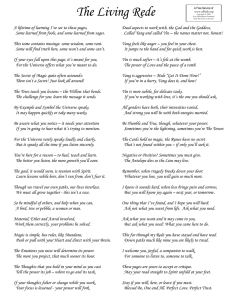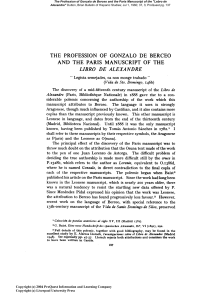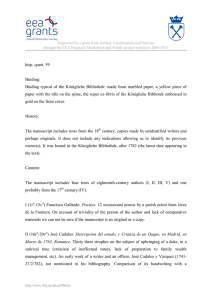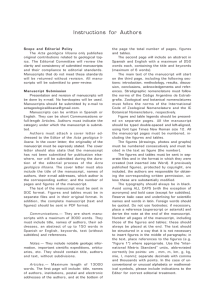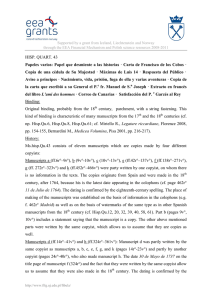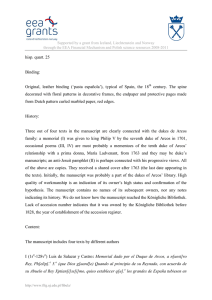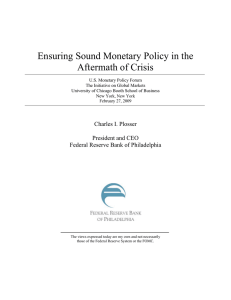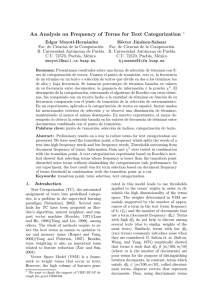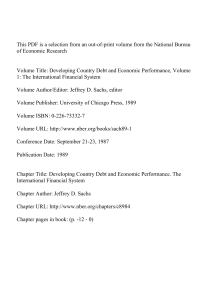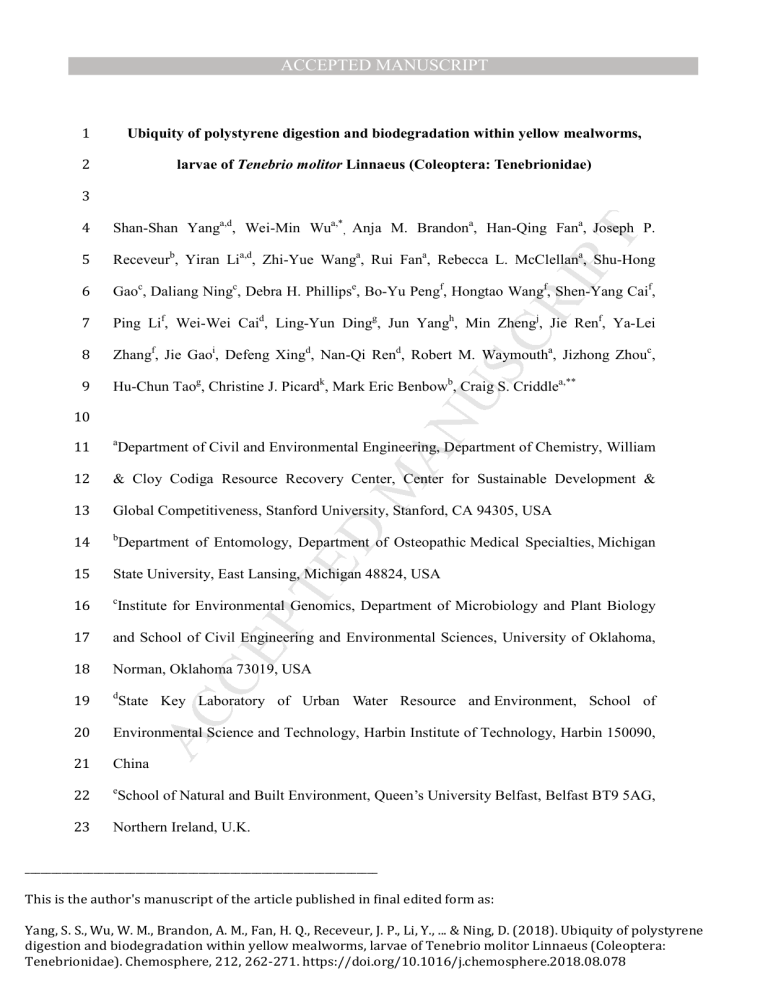
ACCEPTED MANUSCRIPT 1 Ubiquity of polystyrene digestion and biodegradation within yellow mealworms, 2 larvae of Tenebrio molitor Linnaeus (Coleoptera: Tenebrionidae) 3 Shan-Shan Yanga,d, Wei-Min Wua,*, Anja M. Brandona, Han-Qing Fana, Joseph P. 5 Receveurb, Yiran Lia,d, Zhi-Yue Wanga, Rui Fana, Rebecca L. McClellana, Shu-Hong 6 Gaoc, Daliang Ningc, Debra H. Phillipse, Bo-Yu Pengf, Hongtao Wangf, Shen-Yang Caif, 7 Ping Lif, Wei-Wei Caid, Ling-Yun Dingg, Jun Yangh, Min Zhengj, Jie Renf, Ya-Lei 8 Zhangf, Jie Gaoi, Defeng Xingd, Nan-Qi Rend, Robert M. Waymoutha, Jizhong Zhouc, 9 Hu-Chun Taog, Christine J. Picardk, Mark Eric Benbowb, Craig S. Criddlea,** M AN U SC RI PT 4 10 11 a 12 & Cloy Codiga Resource Recovery Center, Center for Sustainable Development & 13 Global Competitiveness, Stanford University, Stanford, CA 94305, USA 14 b 15 State University, East Lansing, Michigan 48824, USA 16 c 17 and School of Civil Engineering and Environmental Sciences, University of Oklahoma, 18 Norman, Oklahoma 73019, USA 19 d 20 Environmental Science and Technology, Harbin Institute of Technology, Harbin 150090, 21 China 22 e 23 Northern Ireland, U.K. TE D Department of Civil and Environmental Engineering, Department of Chemistry, William Department of Entomology, Department of Osteopathic Medical Specialties, Michigan AC C EP Institute for Environmental Genomics, Department of Microbiology and Plant Biology State Key Laboratory of Urban Water Resource and Environment, School of School of Natural and Built Environment, Queen’s University Belfast, Belfast BT9 5AG, ___________________________________________________________________ This is the author's manuscript of the article published in final edited form as: Yang, S. S., Wu, W. M., Brandon, A. M., Fan, H. Q., Receveur, J. P., Li, Y., ... & Ning, D. (2018). Ubiquity of polystyrene digestion and biodegradation within yellow mealworms, larvae of Tenebrio molitor Linnaeus (Coleoptera: Tenebrionidae). Chemosphere, 212, 262-271. https://doi.org/10.1016/j.chemosphere.2018.08.078 ACCEPTED MANUSCRIPT 24 f 25 Engineering, School of Life Science, Tongji University, Shanghai 201804, China 26 g 27 Shenzhen 518055, China 28 h 29 i 30 Beijing, 100085, China 31 j 32 4072, Australia 33 k 34 *Corresponding 35 [email protected] (C.S. Criddle) School of Material Science and Engineering, School of Environmental Science and RI PT School of Environment and Energy, Peking University Shenzhen Graduate School, School of Chemistry, Beihang University, Beijing 100191, China SC Research Center for Eco-Environmental Sciences, Chinese Academy of Sciences, M AN U Advanced Water Management Centre, The University of Queensland, St. Lucia, QLD Department of Biology, IUPUI, Indianapolis, IN46202 author. Email [email protected] (W.-M.Wu), TE D 36 address: ABSTRACT 38 Academics researchers and “citizen scientists” from 22 countries confirmed that yellow 39 mealworms, the larvae of Tenebrio molitor Linnaeus, can survive by eating polystyrene 40 (PS) foam. More detailed assessment of this capability was carried out for mealworms 41 from 12 sources: five from the USA, six from China, and one from Northern Ireland. All 42 of these mealworms digested PS foam. 43 observed, with appearance of lower molecular weight residuals and functional groups 44 indicative of oxidative transformations in extracts from the frass (insect excrement). 45 Addition of gentamycin (30 mg g-1), a bactericidal antibiotic, inhibited depolymerization, 46 implicating the gut microbiome in the biodegradation process. Microbial community AC C EP 37 PS mass decreased and depolymerization was 2 AC C EP TE D M AN U SC RI PT ACCEPTED MANUSCRIPT ACCEPTED MANUSCRIPT analyses demonstrated significant taxonomic shifts for mealworms fed diets of PS plus 48 bran and PS alone. The results indicate that mealworms from diverse locations eat and 49 metabolize PS and support the hypothesis that this capacity is independent of the 50 geographic origin of the mealworms and likely ubiquitous to members of this species. RI PT 47 51 Keywords: Plastic wastes, Polystyrene, Degradation, Mealworms, Tenebrio molitor, gut 53 microbiome SC 52 54 1. Introduction M AN U 55 The accumulation of petroleum-based synthetic plastic wastes, including polystyrene 57 (PS), polyethylene (PE), polypropylene (PP), polyurethane (PUR), polyvinyl chloride 58 (PVC), and polyethylene terephthalate (PET), is a major environmental concern, with up 59 to 6,300 million metric tons generated to date (Geyer et al., 2017). Plastic degradation is 60 defined as a physical or chemical change in the polymer due to environmental factors, 61 such as light, heat, moisture, chemical conditions or biological activity (Shah et al., 2008). 62 During microbial biodegradation, polymers are first depolymerized to smaller monomers 63 which are further degraded for energy or assimilated. Ultimate biodegradation or 64 mineralization is achieved when the degraded monomers are converted to CO2, water, 65 and stabilized microbial biomass. Most petroleum-based plastics are resistant to 66 biodegradation (Otake et al, 1995, Shah et al, 2008). One of the most commonly used 67 plastics is PS, ([-CH-(C6H5) CH2-]n), constituting 7.1% of annual plastic production (Wu 68 et al., 2017). PS products and materials are used in diverse applications, including 69 eyeglasses frames, plastic cups, egg trays, packaging, and building insulation (Plastics AC C EP TE D 56 3 ACCEPTED MANUSCRIPT Europe, 2016). As a consequence, PS has become a major pollutant of soils, rivers, lakes, 71 and oceans (Zhou et al., 2011) and a source of microplastics (<5 mm) (Hidalgo-Ruz et al, 72 2012; Wu et al., 2017). Although resistant to microbial biodegradation in a wide range of 73 habitats (Guillet et al., 1974; Jones et al., 1974; Sielicki et al., 1978; Kaplan et al., 1979; 74 Mor and Sivan, 2008; Råberg et al., 2008), PS is now known to be susceptible to rapid 75 biodegradation in the gut of yellow mealworms (Yang et al., 2015a, 2015b; Yang et al. 76 2018; Brandon et al. 2018), the larval form of Tenebrio molitor Linnaeus (Howard, 1955; 77 Roberson, 2005; Löbl et al., 2008). SC RI PT 70 T. molitor belongs to the order Coleoptera (beetles) and family Tenebrionidae 79 (common name “darkling beetle”), a cosmopolitan family of beetles with more than 80 20,000 species. Since the 1950’s, researchers have observed that some beetles and larvae 81 in the Tenebrionidae family damaged plastic packaging materials (Gerhardt and Lindgren, 82 1954; Cline, 1978; Newton, 1988). Subsequently, consumption of PS foams by 83 mealworms was reported by students competing in high school science fairs: in 2003, Ms. 84 Chong-Guan Chen raised mealworms fed PS foam and theorized that the PS biodegraded 85 (Sina, 2003); in 2009, Ms. I-Ching Tseng isolated bacteria from mealworms gut using PS 86 as the sole carbon source (Burkart, 2009). Convincing academic evidence of PS 87 degradation was reported in mealworms from Beijing, China (Yang et al., 2015a) then in 88 a mealworm strain 89 week adaptation period, the polymer fraction of ingested Styrofoam decreased by up to 90 65% with a 12-15 hr gut retention time (Yang et al., 2018). Almost half of the ingested 91 PS carbon was converted into CO2 in the mealworm gut (Yang et al. 2015a; Brandon et 92 al., 2018). Isotopic studies using AC C EP TE D M AN U 78 from a pet store in the United States (Yang et al., 2018). After a 1-2 13 C-labeled PS materials have shown that PS was 4 ACCEPTED MANUSCRIPT 13 93 mineralized to 94 with the antibiotic gentamycin, mealworm strain from Beijing almost completely lost the 95 ability to depolymerize PS and mineralize PS into CO2, implicating gut bacteria in PS 96 biodegradation (Yang et al., 2015b). Additional studies on the same strains of mealworms 97 isolated a PS-degrading bacteria strain (Exiguobacterium sp.) (Yang et al. 2015b) and 98 indicated that co-feeding with bran resulted in enhanced PS degradation and enabled 99 mealworms to consume PS for multiple generations (Yang et al. 2018). SC RI PT CO2 and incorporated into lipids (Yang et al., 2015a). After being fed In this study, we test the hypothesis that PS degradation in mealworms is 101 ubiquitous. Evaluation of this hypothesis is needed because prior work has focused on 102 mealworms from just two sources (Yang et al., 2015a; Yang et al., 2018). To assess plastic 103 biodegradation for mealworms from a broader range of sources, we enlisted the help of 104 academic and non-academic institutions from around the world to collect information 105 about mealworm behavior related to plastic consumption. We also obtained mealworms 106 from 12 different sources and tested them for PS degradation using standard protocols 107 (Yang et al., 2015a; Yang et al., 2018), including PS mass balances to determine the 108 specific rates of PS degradation; (2) gel permeation chromatography (GPC) to assess 109 changes in molecular weight, and (3) Fourier transform infrared (FTIR) spectroscopy of 110 frass residues to identify chemical modifications resulting from PS digestion. TE D EP AC C 111 M AN U 100 We find that mealworms from diverse locations share the ability to consume and 112 degrade PS. We also report observation that add to the existing body of evidence that the 113 gut microbiome plays a role in PS depolymerization and degradation. These microbiomes 114 differ for microorganisms from different sources, with shifts in microbial community 115 structure observed when mealworms are fed PS. 5 ACCEPTED MANUSCRIPT 116 2. Methods 117 2.1. Worldwide survey One of the co-authors (W.-M. Wu, Stanford University) organized and supervised a 119 worldwide survey with volunteer investigators from around world, including middle 120 school and high school students, university students, school teachers, professors, 121 mealworm farmers and mealworm breeders. These diverse collabroators obtained locally 122 available mealworms and fed them PS materials, including Styrofoam, XPS, and other PS 123 foams. Information of the location of the investigator, source of mealworms, test 124 materials and plastic-eating and consumption behavior is summarized in the 125 Supplementary data. Web searches for literature, science fair news and YouTube videos 126 were also used to obtain information on mealworms eating patterns and degradation of 127 PS and other plastics within mealworms. 128 2.2 Source of mealworms TE D M AN U SC RI PT 118 Mealworms (developmental stage: instar 5 -7) from the twelve sources (five in the 130 USA, six in China, and one in the United Kingdom) were obtained by: (1) direct purchase 131 from the PetCo Pet Store Chain, Mountain View, California (supplied to the store by 132 Timberline Fisheries); (2) direct purchase from the PetSmart Pet Store Chain, Sunnyvale, 133 California (supplied by Bug Company, Ham Lake, Minnesota ); (3) mail order from 134 Timberline Fisheries, Marion, Illinois (ordered separately from source 1); (4) mail order 135 from Exotic Nutrition Pet Company, Newport News, Virginia; (5) mail order from 136 Rainbow Mealworms, Compton, California; (6) direct purchase from a pet store in Belfast, 137 Northern Ireland, UK; (7) direct purchase from a pet store in Beijing; (8) mail order from a store 138 in Harbin, Heilongjiang Province; (9) direct purchase from a mealworm farm in Tai’an County, 139 Shandong Province; (10) direct purchase from a pet store in Xi’an City, Shaanxi Province; (11) AC C EP 129 6 ACCEPTED MANUSCRIPT direct purchase from a pet store in Shanghai; (12) mail order from and a pet store in Shenzhen 141 City, Guangdong Province (Table 1). All larvae were identified as Tenebrio molitor Linnaeus 142 based on morphology and coloration. Prior to arrival, and for at least two days prior to PS 143 degradation tests, the larvae were fed bran and maintained in incubators with bran. 144 2.3. PS feedstocks RI PT 140 Mealworms received one of three PS feedstocks, labeled A, B, or C. These feedstocks 146 had similar density (0.020-0.021 g cm-3) and similar molecular weights (Table S1, 147 Supplementary data). Average molecular weights of the feedstock materials were 148 determined in the analytical laboratories of the Department of Chemistry, Stanford 149 University. Feedstock A consisted of Styrofoam plates from Insulfoam (Carlisle 150 Construction Materials, Puyallup, WA), the number-average molecular weight (Mn) was 151 90,000±2,000, and the weight-averaged molecular weight (Mw) was 228,000± 1,000. 152 Feedstock B consisted of white EPS70 SDN insulation Styrofoam from UK Packaging 153 Suppliers (Staffordshire, UK), with Mn of 89,000 ± 2,000, and Mw of 210,000 ± 2,000. 154 Feedstock C consisted of Styrofoam packing material from Shenzhen, China, with Mn of 155 93,000 ± 3,000, and Mw of 254,000 ± 1000. M AN U TE D EP 157 2.4. PS biodegradation capability AC C 156 SC 145 158 Mealworms in developmental stages instar 7-8 were cultivated in food grade high 159 density polypropylene (PP) storage containers in laboratories at Stanford, CA, USA; 160 Beijing, China; and Belfast, UK. The set up and methods used were similar to those 161 previously reported (Yang et al., 2018). At Stanford, 120 mealworms were incubated in 162 475 mL PP containers; in Northern Ireland 200 mealworms were incubated in 600 mL 163 containers; in China, 500 mealworms were incubated in 1200 mL containers. In each 7 ACCEPTED MANUSCRIPT incubator, the spatial density of the mealworms was ~2 worms cm-2. The humidity within 165 the containers was maintained at 75-80%. Temperature was maintained at 25 oC at 166 Stanford, 24-26 oC in Belfast, and 26-27 oC in Beijing. Mealworms from US sources 1-5 167 and Chinese sources 7-11 received Feedstock A; mealworms from the UK source 6 168 received Feedstock B; mealworms from Chinese source 12 received feedstock C. All tests 169 in the USA and UK were performed in duplicate. An additional test was performed at 170 Tongji University: mealworms from source 11 (Shanghai) were tested for survival under 171 different feed conditions at ambient temperature (25-26 oC) over a 34-day test period. SC RI PT 164 At Stanford, mealworms were fed PS alone and PS plus bran. To initiate these tests, 1.80 173 g PS feedstock was added to each incubator. For the PS alone diet, no additional PS was 174 added thereafter. For the PS plus bran diet, each incubator received 3.6 g bran supplements 175 every 4 days, resulting in a cumulative bran to PS ratio (B/PS) of 14:1 over a 32-day period 176 (Yang et al., 2018). In Belfast, all incubators initially received PS (1.0 g). For the PS alone 177 diet, no additional PS was added thereafter. For the PS plus bran diet, bran supplements 178 (1.0 g) were provided weekly. Unfed mealworms were used as control. In Beijing, 179 mealworm incubators were fed PS plus bran. Each incubator initially received 8.3 g PS 180 plus 14.8 g bran; this was followed by 14.8 g bran supplements every 4 days thereafter, 181 resulting in a cumulative B/P ratio of 8.9:1 over a 24-day period. In tests at all three labs, 182 dead mealworms were removed whenever observed. Tests conducted at Tongji University 183 were carried out in four incubators initially containing 410 mealworms per incubator. 184 Mealworms were fed one of three diets at the beginning : (1) 8.5 g bran, (2) 4.70 g PS, and 185 (3) 4.7 g PS plus 8.5 g bran. Bran was supplemented every 5 days with a cumulative B/P 186 ratio of 14.5:1. Unfed controls were also evaluated. AC C EP TE D M AN U 172 8 ACCEPTED MANUSCRIPT Mealworm survival rates (SRs) and PS mass losses were monitored and calculated. For 188 DNA analyses, mealworms samples (at least 30) were collected, preserved with 100% 189 ethanol (analytical grade) and stored at -80 oC. 190 2.5. Characterization of feedstock and frass RI PT 187 Biodegradation and depolymerization of ingested PS was assessed by GPC and FTIR 192 analyses of feedstock and frass. Frass from each incubator was collected and extracted as 193 described in the Supplementary data and a previous report (Yang et al., 2018). The 194 respective feedstock PS materials were extracted using the same procedures as frass 195 samples prior to GPC analysis. Triplicate GPC analyses were carried out at Stanford 196 University to determine Mn, Mw and molecular weight distribution (MWD) of feedstock 197 and frass samples. Triplicate 100-µL frass extract samples were injected into a GPC 198 operating at a THF eluent flow rate of 1.0 mL min-1 at 40 oC (Viscotek GPCmax VE 199 2001 GPC Solvent/Sample Module, Viscotek Corporation, Houston, Texas, USA). 200 Triplicate FTIR analyses (EQUINOX 55 FT-IR Spectrometer, Bruker Corporation, 201 Ettlingen, Germany) were performed at Tongji University to characterize functional 202 groups in PS feedstocks and frass samples over the range 400-4000 cm−1. 203 2.6. Effect of Antibiotics on PS Degradation EP TE D M AN U SC 191 The effect of antibiotic suppression on PS depolymerization and degradation was 205 tested using mealworms from US sources 1-5 and gentamicin as an inhibitor. Gentamicin 206 was selected based on the results of Yang et al. (2015b). Mealworms (120 per container) 207 were fed bran mixed with gentamicin sulfate (Cat# 00149, Lot# 001204-15032306, 208 Chem-Impex Int’l Inc., USA) at a dosage of 30 mg gentamicin sulfate per gram of bran. 209 Controls were fed bran alone. On day 0, 7, and 15, 15 mealworms in each incubator were AC C 204 9 ACCEPTED MANUSCRIPT randomly chosen from each source of mealworms to prepare a gut suspension for 211 counting of gut microorganisms. The surfaces of the worms were decontaminated by 212 immersion in 70% ethanol for 1 min then rinsing twice with distilled water. The gut 213 contents of 15 mealworms from each source were then extracted and suspended in 5 ml 214 sterilized saline water (7.5% NaCl). This initial gut suspension was diluted using a 215 five-step ten-fold serial dilution (10-1 to 10-5) and spread on Trypticase soy agar (TSA) 216 plates containing 15 g L-1 tryptone, 5 g L-1 soytone, 5 g L-1 sodium chloride, 15 g L-1 agar, 217 pH 7.3± 0.2, a general-purpose, nonselective medium providing enough nutrients to 218 allow for a growth of a wide variety of microorganisms. After incubation for 24 hrs (at 30 219 o 220 treatment and the control treatment were fed PS feedstock. Gentamicin sulfate mixed 221 bran (30 mg gentamicin sulfate g bran-1) was then continuously supplied to the treatment 222 group until day 15. Over the 15-day incubation period, frass samples from both treatment 223 and control incubations were collected for GPC analysis. 224 2.7. Gut Microbial community analysis M AN U SC RI PT 210 TE D C), the number of colonies were counted. On day 7, mealworms from the antibiotic 225 EP Mealworm samples from each strain were collected, preserved in 100% ethanol at -80 226 o 227 externally decontaminated larval mealworms was performed using the DNeasy Blood and 228 Tissue kit (Qiagen) before library construction and sequencing (2 x 250 bp paired-end 229 reads, Illumina MiSeq) were performed at the Michigan State University Genomics Core 230 Facility. Sequencing reads were filtered and taxonomically assigned using QIIME 2. 231 Additional methods are available in the supplemental materials. AC C C, and shipped to the lab for microbial community analysis. DNA extraction from 232 10 ACCEPTED MANUSCRIPT 233 3. Results and discussion 234 3.1. Ubiquity of plastic eating behavior among mealworms Survey responses from collaborators in 22 countries (Fig. 1) indicated that 236 mealworms in all locations consumed PS foam, including mealworms from North 237 America (Canada, Mexico, USA); Asia (Cambodia, China, Japan, Indonesia, Iran, Israel, 238 South Korea, Thailand); Europe (Finland, France, Germany, Poland, Slovenia, Spain, 239 Turkey, UK); Africa (Nigeria, South Africa) and Australia. From these results, we 240 surmise that chewing and ingestion of PS is likely an adaptive behavior intrinsic to 241 yellow mealworms, which feed upon decaying forest vegetation in natural settings 242 (Howard, 1955). Marshall School students (Duluth MN, USA) reported 33 mg PS 100 243 worms-1 d-1, within the range of previous tests; a team at the University of Queensland, St. 244 Lucia, Australia, reported that local mealworms consumed PS at a rate of 13 mg PS 100 245 worms-1 d-1; a team in Bandar Lampung, Indonesia, reported that PS foam feeds 246 supported mealworm growth, and the feed had no significant effect on larvae mortality 247 (Nukmal et al., 2018); and students reported formation of beetles from larvae when fed 248 PS plus bran, confirming prior reports (Yang et al., 2015a; Yang et al., 2018). 249 Mealworms were also observed consuming PE, an observation now documented in the 250 peer-reviewed literature (Brandon et al., 2018), as well as other plastics, including PVC 251 and PLA, as reported by an academic team in Poland (Boźek et al., 2017). 252 3.2. Ubiquity of biodegradation of PS AC C EP TE D M AN U SC RI PT 235 253 The ubiquity of PS biodegradation was evaluated by testing mealworms from twelve 254 distinct geographic locations with three PS feedstocks (Table 1). All mealworms chewed 255 and ingested PS (Fig. 2). For mealworms from sources 1-6, 32-day survival rates (SRs) 11 ACCEPTED MANUSCRIPT 256 for mealworms fed PS alone exceeded 80% (Table 1). These values were statistically 257 indistinguishable from the 32-day SRs of mealworms fed PS plus bran (Table 1). Over a 32-day period, SRs for mealworms from US sources 2 through 5 were higher 259 for mealworms fed bran only (88-90%), PS plus bran (85-92%), and PS only (83-92%) 260 than for unfed mealworms (69-76%) (Table 1 and Fig. S2, Table S1). Higher SRs were 261 also observed in mealworms from source 11 (Shanghai) when fed PS plus bran (95%) or 262 PS only (92%) compared to unfed mealworms (68%) over a 34-day period (Fig. S1C, 263 Table S2). SC RI PT 258 The average weight of mealworms from source 6 (Northern Ireland) increased by 22% 265 over a 34-day period when fed bran or PS plus bran, but only increased by 7.3% when 266 fed PS alone, and decreased by 8.2% when unfed (Table 1). Similarly, the average weight 267 of mealworms from source 11 (Shanghai) increased by 16-25% over a 34-day period for 268 mealworms fed bran or PS plus bran, but decreased by 9.3% when fed PS alone and by 269 17.4% when unfed (Table S2, Supplementary data). TE D M AN U 264 These results indicate that digestion of ingested PS can provide significant energy 271 (source 6) and offset energy requirements for maintenance for over one month (source 272 11). In a previous test of the Beijing strain fed α 13C- and β 13C-labelled PS (Yang et al., 273 2015a), individual fatty acids had δ 274 bran-fed controls, especially in unsaturated FAs, indicating that 13C from the 13C-labeled 275 PS was assimilated into mealworm biomass. This is evidence that PS digestion can 276 provide both energy and carbon for mealworm maintenance and survival during the first 277 month of cultivation (Yang et al., 2015a; Yang et al., 2018). Further studies are needed 278 to understand the conditions regulating the mechanisms of energy recovery from AC C EP 270 13 C values that were significantly higher than 12 ACCEPTED MANUSCRIPT 279 plastic consumption. Whether the mealworms obtain sufficient energy for 280 maintenance likely depends upon the PS consumption rate and digestibility of the PS 281 consumed. In the 98-day tests of mealworms from source 6, the SRs of mealworms fed PS alone 283 matched those fed PS plus bran during the initial 35 days of incubation (95.5% versus 284 98.0%) then dropped to low levels, like those of unfed controls (Table 1). Further 285 investigation revealed that both the unfed mealworms and mealworms fed PS alone 286 engaged in cannibalism. The 98-day SR was 11.8±1.1% for unfed mealworms, and 287 11.5±4.9% for mealworms fed PS alone. By contrast, the 98-day SR for mealworms fed 288 bran plus PS was 81.5±7.1 % (Fig. S1B). Because PS contains only hydrogen and carbon, 289 it does not provide adequate nutrition (N, P, Na, K, trace elements, amino acids, etc.) for 290 long-term survival and growth. The positive effect of PS on SR does not last for long 291 time due to the lack of nitrogen sources and other nutrients. Addition of bran relieved this 292 constraint. In the absence of added bran, however, PS-fed mealworms survived by 293 consuming dead mealworms and their molts. The survivors (about 12% of the original 294 population) maintained a biomass similar to those that received bran (Table 1). EP TE D M AN U SC RI PT 282 Specific PS consumption rates from US sources 1-6 and Northern Ireland UK source 7 296 were compared for mealworms fed PS alone and bran plus PS (Table 1). Mealworms fed 297 bran plus PS typically consumed PS at rates that were more than twice those of 298 mealworms fed PS alone. Not surprisingly, mealworms from sources 1 and 2 (same 299 source, but different batch) had similar PS specific consumption rates. The initial size of 300 the mealworms had no clear impact on the rate of PS consumption, but the lightest AC C 295 13 ACCEPTED MANUSCRIPT 301 mealworms (source 6; average weight 33.5 mg) consumed PS at the highest rate (7.64 mg 302 PS g worms -1 d-1). For the mealworms obtained in China, PS consumption rates were evaluated under 304 relatively optimal conditions. While the results varied, the ranges observed were similar 305 to those of mealworms from the USA and Noth Ireland (Table 1). 306 3.3. Characterizations of the egested frass RI PT 303 During incubation with PS as a feedstock, decreases in Mn and Mw and MWD shifts to 308 were monitored (Albertsson et al., 1998; Yang et al., 2015a; Yang et al., 2018). Fig. 3 309 shows evidence of PS depolymerization within the guts of mealworms from all 12 310 sources, with significant decreases in Mn and Mw accompanied by shifts in MWD to 311 lower molecular weights (t test p<0.05 in Table S2). M AN U SC 307 Frass samples from mealworms from US sources 1-5 and Chinese sources 7-11 313 contained polymer extracts with Mn values that were 9.1-15.6% lower than the feedstock 314 and Mw values that were 5.2 -10.8% lower than the feedstock (Feedstock A with Mn of 315 90,000±2000; Mw of 228,000±1,200) (Table S3, Supplementary data). Frass samples 316 from mealworms from Northern Ireland (source 6) had Mn values that were 5.4 % lower 317 and Mw values that were 12.1% lower than the feed (Feedstock B with Mn of 318 89,000±2,000; Mw of 210,000±2,000). For frass samples from Chinese source 12, Mn 319 values were 11.2 % lower, and Mw values were 9.0% lower than the feed (Feedstock C 320 with Mn of 93,000 ± 3,000 and Mw of 250,000±1000 (Table S3). These decreases in Mn 321 and Mw were significant for all sources (t-test, p<0.05, Table S2), indicating 322 depolymerization and degradation of PS feedstock was ubiquitous across all 12 source 323 populations. AC C EP TE D 312 14 ACCEPTED MANUSCRIPT FTIR analyses verified the formation of new functional groups during passage through 325 the mealworm gut. Comparison of FTIR spectra for the PS feed stock (control) and 326 egested frass of all tested mealworms showed chemical changes and incorporation of 327 oxygen previously linked to plastic degradation (Fig. 4 A and 4B, Fig. S3 and S4, 328 Supplementary data). 329 2018, Brandon et al., 2018). The spectra of frass from mealworms fed with PS and PS 330 plus bran are significantly different from the frass of mealworms fed bran only (Fig. 4A 331 and Fig. S3, Supplementary data). Peaks at 625-970 cm-1 (ring-bending vibration) had 332 high intensities in the PS feedstock but were much weaker in frass samples. Peaks 333 characteristic of the PS benzene ring (C=C stretch, 1550-1610 and 1800-2000 cm-1) were 334 dampened in frass of mealworms fed PS or PS plus bran, suggesting ring cleavage. The 335 PS fed samples showed a decrease intensity for peaks characteristic of PS (Sekhar et al., 336 2016) and appearance of more carbonyl groups (C=O stretching, 1700 cm-1) compared 337 with 338 data). The broadening of peaks at 2500-3500 cm-1 in all FTIR spectra is associated with 339 the hydrogen bond of hydroxyl groups and/or carboxylic acid groups, suggested a shift 340 from hydrophobic to more hydrophilic surface properties. FTIR analysis confirmed that 341 all frass samples showed strong signs of PS biodegradation, as observed in previous tests 342 of mealworms from Beijing (Yang et al., 2015a) and a California PetCo store (Yang et al., 343 2018). 344 3.4. Effect of gentamicin on PS depolymerization RI PT 324 TE D M AN U SC These data are similar to those previously reported (Yang et al, AC C EP samples fed bran alone or PS feedstock (Fig.4A and 4B, Fig. S3, Supplementary 345 Antibiotics, such as nystatin and ampicillin, suppress gut microbiota in mealworms and 346 provide insight into the role that gut microbiota play in digestive processes, such as the 15 ACCEPTED MANUSCRIPT digestion of cell walls and glucoside detoxification (Genta et al., 2006). Previous studies 348 have inferred that gut microbes were required for PS biodegradation due to suppression 349 of PS degradation when gentamycin was added (Yang et al., 2015b). Gentamicin addition 350 to the diets of mealworms from the five USA sources were used to examine the role of 351 gut bacteria on PS depolymerization/biodegradation. After feeding gentamicin sulfate 352 plus bran for 7 days, gut bacteria numbers dropped significantly from 106 levels by 2-3 353 magnitutes compared to controls (Fig. 4C and Table S5), indicating suppression of the 354 gut bacteria. After 15 days, frass samples were collected for tetrahydrofuran (THF) 355 extraction and GPC analysis of residual polymers. GPC analyses indicated inhibition of 356 depolymerization when the mealworms were fed gentamicin-containing bran, but 357 depolymerization remained elevated in the control treatment (Fig. 4D and 4E). No 358 statistically significant differences were observed in Mw and Mn values between PS feed 359 stock and residual polymers extracted from frass samples of mealworms receiving the 360 gentamicin treatment for all five US sources (Table S6). 361 differences were observed in Mw and Mn values between PS fed stock and residual 362 polymers extracted from control and gentamicin treatments (Tables S6 and S7). This is 363 evidence that gentamycin suppressed gut microbiota and inhibited PS depolymerization. 364 From these results, we hypothesize that the depolymerization of PS may be induced by 365 gut microbes that are directly in contact with PS or entail synergetic effects involving gut 366 microflora and mealworm digestive enzymes within the gut. Our results showed that 367 unfed mealworms showed slight but reproducibly lower SR. It seems that microbes in the 368 gut of mealworms cause a partial depolymerisation of PS with the release of broken down 369 substances which sustain the SR of mealworms even in the absence of other nutrients On the other hand, significant AC C EP TE D M AN U SC RI PT 347 16 ACCEPTED MANUSCRIPT 370 (such as bran). Further study is needed to examine wether antibiotics causes lower SR for 371 mealwornms fed PS only. 372 3.5. Gut Microbial community analyses The dominant bacterial phyla across all mealworm samples, representing greater than 374 99% average relative abundance in the measured bacterial communities, were 375 Actinobacteria, Firmicutes, Proteobacteria and Tenericutes. The six most abundant 376 families 377 Enterobacteriaceae, 378 Streptococcaceae representing a diverse range of mostly aerobic and/or facultative 379 bacteria. Fig. 5 illustrates differences in bacterial taxa between mealworms fed normal 380 feed bran (Original) and mealworms fed PS alone and PS plus bran (PS/Bran). The 381 original bacterial communities varied greatly between source populations, likely due to 382 differences in diet at different geographic locations and strain-specific properties (genes, 383 growth condition and history). However, after mealworms switched diets from bran to PS 384 plus bran or to PS alone, the gut microbial communities converged on similar patterns 385 independent of the mealworm source. total relative abundance Enterococcaceae, on average) were SC 98% Lactobacillaceae, Bacillaceae, Leuconostocaceae, and EP TE D M AN U (> RI PT 373 At the phylum level, the relative abundance of Firmicutes decreased significantly in 387 the PS-only diets (P = 0.0055) and the PS plus bran diet (Wilcox, P = 0.0035). There were 388 no significant differences between the PS-only diet and the PS plus bran diet (P = 0.293). 389 Firmicutes include Clostridia (anaerobic bacteria) and Bacilli (aerobic bacteria), and both 390 are spore formers. No other phyla were significantly different between treatments though 391 Proteobacteria abundance showed an inverse relationship with Firmicutes (Fig. 5A). At 392 the family level, Enterobacteriaceae represented 33.7% (SE±6.3%) of total relative AC C 386 17 ACCEPTED MANUSCRIPT abundance in the original diet, 64.6±12.5% in the PS-only diet, and 50.2±6.5% in the PS 394 plus bran diet (Fig. 5B). After adjusting P values for multiple comparisons, there were no 395 significant differences in relative abundance of any family. At the genus level, Erwinia 396 was the most prevalent genus, representing 25.3 ±5.65% in the original treatment, 397 49.1±17.6% in the PS-only treatment, and 31.2±5.64% in the PS plus bran treatment, 398 with no significant differences between diets (Fig. 5C). RI PT 393 When the diet of the mealworms shifted from bran to PS-only or PS plus bran, the 400 gut microbiota shifted to a community with improved capabilities for PS degradation. At 401 present, however, it is difficult to prove which microbial genera or families are 402 responsible for enhanced PS degradation because only a few PS-degrading bacteria have 403 been isolated. These include PS-degrading Exiguobacterium sp. YT2 (Yang et al., 2015b), 404 Phylum: Firmicutes; Class Bacilli, and Rhodococcus ruber (Mor and Siva, 2008), Phylum 405 Actinobacteria, Family Nocardiaceae. Recently, Tang et al., (2017) reported two bacterial 406 strains isolated from the guts of mealworms and superworms’ that are capable of growing 407 on PS - Aeromonas sp and Klebsiella pneumoniae - both of which belong to the family 408 Enterobacteriaceae (P Proteobacteria, C Gammaproteobacteria). It is reasonable to 409 hypothesize that PS-degrading bacteria are able to secrete extracellular oxidative 410 enzyme(s) that break down PS polymer chains and generate intermediates with C=O 411 bonds; features present in broad families of aerobic or facultative bacteria. Additional 412 isolation and characterization of PS-degrading species is needed to enable identification 413 of key functional enzymes involved in the depolymerization and biodegradation of PS, 414 PE and other plastics. 415 mealworms were fed a diet containing PS, this work suggests that bacteria responsible for AC C EP TE D M AN U SC 399 Given the shifts in taxonomic composition that occurred after the 18 ACCEPTED MANUSCRIPT 416 depolymerizing PS and degradation of intermediates likely include Gram-positive 417 Clostridia (anaerobic conditions), Gram-negative Enterobacteriaceaea (anaerobic-aerobic 418 conditions) and Gram-positive Bacillus (aerobic conditions). The results of this study indicate that microbiomes capable of depolymerizing PS 420 are widely present in mealworm gut from various sources and that shifts in gut microbial 421 communities may be a direct result of PS consumption (i.e. a changing community to 422 better degrade plastics) or an indirect response (i.e. a response to nutrient deprivation due 423 to the limited diet). We did not evaluate changes in the gut microbial community under 424 starvation conditions and additional studies of such conditions are warranted. M AN U SC RI PT 419 425 426 427 3.6. Significance of the ubiquity of PS degradation by mealworms The results of the global survey strongly suggest that mealworm ingestion of plastic 429 foams, like Styrofoam, is genetically-programmed and ubiquitous. Rapid PS 430 depolymerization was observed, as observed previously (Yang et al., 2015a; Yang et al., 431 2018), and this capability is apparently conserved in mealworm populations throughout 432 the world. These mealworm populations ingest and use PS foam as a food (energy) 433 source for survival, and this behavior is not limited to PS: PE can be consumed even 434 more rapidly than PS. Approximately 49.0±1.4% of ingested PE was converted into a 435 putative gas fraction (i.e. CO2) (Brandon et al., 2018). Evidence of mealworm 436 consumption is now available for many other materials, including PP, PVC, PET and 437 PUR at laboratories in the USA and China (data not shown). Other academic researchers 438 have reported mealworm consumption of PVC and PLA (Boźek et al., 2017). 439 AC C EP TE D 428 Chewing of plastic into small fragments increases the surface area of the ingested 19 ACCEPTED MANUSCRIPT plastic and thus likely enhances enzymatic depolymerization, but depolymerization of the 441 ingested plastic was not completed in the 14-18 hour transit time through the mealworm 442 gut. Residual PS in the frass contributes to the THF extractable fraction, constituting ~35% 443 of the weight of frass (Yang et al., 2018). Further testing is needed to determine whether 444 this residual is recalcitrant, say, for example, because of crystallinity differences in the PS 445 feedstock, or whether this PS could be degraded with additional residence time in the 446 mealworm gut. In any case, this work establishes that ingestion of PS and PE plastic 447 foam can provide energy for maintenance of mealworm populations for 4-5 weeks. 448 However, a sustained diet of plastic without supplemental nutrition does not enable 449 reproduction of mealworms (Yang et al., 2018) and eventually leads to canabalism. M AN U SC RI PT 440 The ability of insects to depolymerize diverse plastics is likely ubiquitous and not 451 restricted to mealworms. The fact that insect pests, including darkling beetles (Tribolium 452 castaneum, Rhizopertha Lasioderma serricorne, Tnebrioide mauretanicus, Zophobas 453 morio etc. in family Tenebrionidae ) and several moths and their larvae (Plodia 454 interpunctella, Galleria mellonella in the Family Pyralidae) can chew, eat, and penetrate 455 various plastic packing materials has been established since the 1950s (Gerhardt and 456 Lindgren, 1954; Cline, 1978; Newton, 1988; Bombelli et al., 2017). These early studies 457 established that insect larvae chew and damage PE, PVC and polyester films regardless 458 of whether the film was used to cover food (Cline 1978), suggesting that the larvae of 459 insect pests may also ingest plastics as food. Recent studies indicated that the larvae of 460 Plodia interpunctella (Indian meal moth) and Galleria mellonella, or honey waxworms, 461 can chew and likely degrade PE films (Yang et al., 2014; Bombelli et al., 2017). 462 4. Conclusions AC C EP TE D 450 20 ACCEPTED MANUSCRIPT This work establishes that mealworms have an intrinsic capacity for biodegradation 464 of PS due to their intrinsic eating and chewing behaviors and gut microbe-dependent 465 oxidative digestive machinery. Digestion of PS contribute to the energy needs of the 466 mealworms. These features appear to be ubiquitous within mealworms from diverse 467 geographic locations and can be enhanced by co-feeding of nutrient sources such as bran. 468 The contributing gut microbial communities are diverse and subject to dietary control. RI PT 463 SC 469 Acknowledgments 471 This work was supported in part by the Woods Institute for Environment at Stanford 472 University (award 1197667-10-WTAZB) and in part by US National Science Foundation 473 SBIR award 1648559. Dr. Shangshang Yang was supported by the Harbin Institute of 474 Technology, Harbin, China. We also gratefully acknowledge helpful suggestions from Dr. 475 Yu Yang, Beihang University, Beijing, China, and from Drs. Virginia Emery and Hans 476 Kelstrup, Beta Hatch Corp., Seattle, Washington. Finally, we thank Mr. Jack Chiueh, 477 Stanford University, for administrative help and Ms. Andria T. Wu, DePaul University, 478 for figure preparation. The authors offer their deepest appreciation and thanks to the 479 many researchers from around the world who contributed to the mealworm survey 480 reported here. 482 483 TE D EP AC C 481 M AN U 470 Appendix A. Supplementary data Supplementary data related to this article can be found at … 484 485 References 21 ACCEPTED MANUSCRIPT 486 Albertsson, A.C., Erlandsson, B., Hakkarainen. M., Karlsson, S., 1998. Molecular weight 487 changes and polymeric matrix changes correlated with the formation of degradation 488 products in biodegraded polyethylene. J. Environ. Polym. Degrad. 6, 187-195. 491 492 493 RI PT 490 Bombelli, P., Howe, C. J., Bertocchini, F., 2017. Polyethylene bio-degradation by caterpillars of the wax moth Galleria mellonella. Curr. Biol. 27 (8), R292-R293. Boźek, M., Hanus-Lorenz, B., Rybak, J., 2017. The studies on waste biodegradation by Tenebrio molitor. E3S Web of Conferences 17, 00011. SC 489 Brandon, A.M., Gao, S.H., Tian, R., Ning, D.L., Yang, S.S., Zhou, J. Z., Wu, W.M., Criddle, C.S., 2018. Biodegradation of polyethylene in mealworms (larvae of 495 Tenebrio molitor Linneaus): depolymerization, mineralization, and effects on the gut 496 microbiome. Environ. Sci. Technol. 52, 6526−6533 497 M AN U 494 Burkart, K., 2009. High school girl discovers Styrofoam-eating bacterium. Mother Nature Network. 499 <http://www.mnn.com/green-tech/research-innovations/blogs/high-school-girl-disco 500 vers-styrofoam-eating-bacterium>. (last accessed 08.02.2017). 503 504 505 EP 502 Cline, L.D., 1978. Penetration of seven common flexible packaging materials by larvae and adults of eleven species of stored product insects. J. Eco. Entomol. 71, 726-729. Genta, F. A., Dillon, R. J., Terra, W. R., Ferreira, C. 2006. Potential role for gut AC C 501 TE D 498 microbiota in cell wall digestion and glucoside detoxification in Tenebrio molitor larvae. J. Insect Physiol. 52, 593-601. 506 Gerhardt, P.D., Lindgren, D.L., 1954. Penetration of packaging films: film materials used 507 for food packaging tested for resistance to some common stored-product insects. 508 Calif. Agr. 8, 3-4. 22 ACCEPTED MANUSCRIPT 509 510 511 Geyer, R., Jambeck, J.R., Law, K.L., 2017. Production, use, and fate of all plastics ever made. Sci. Adv. 2017: 3: e1700782, DOI: 10.1126/sciadv.1700782. Guillet, J.E., Regulski, T.W., McAneney, T.B., 1974. Biodegradability of photodegraded polymers II: tracer studies of biooxidation of Ecolyte PS polystyrene. Environ. Sci. 513 Technol. 8, 923-925. RI PT 512 Hidalgo-Ruz, V., Gutow, L., Thompson, R.C., Thiel, M., 2012. Microplastics in the 515 marine environment: a review of the methods used for identification and 516 quantification. Environ. Sci. Technol. 46, 3060-3075. 518 Howard, R.S., 1955. The biology of the grain beetle Tenebrio molitor with particular M AN U 517 SC 514 reference to its behavior. Ecology 36 (2), 262-269. Jones, P.H., Prasad, D., Heskins, M., Morgan, M.H., Guillet, J.E., 1974. Biodegradability 520 of photodegraded polymers. I. Development of experimental procedures. Environ. 521 Sci. Technol. 8, 919-923. 522 TE D 519 Kaplan, D.L., Hartenstein, R., Sutter, J., 1979. Biodegradation of polystyrene, poly(methyl methacrylate), and phenol formaldehyde. Appl. Environ. Microbiol. 38 524 (3), 551-553. EP 523 Löbl, I., Merkl, O., Ando, K., Bouchard, P., Egorov, L.V., Iwan, D., Lillig, M., Masumoto, 526 K., Nabozhenko, M., Noväk, V., Petterson, R., Schawaller, W., Soldati, F., 2008. 527 528 529 530 531 AC C 525 Family Tenebrionidae Latreille: 30-45, 105-352 and 467-645. In: Löbl, I., Smetana, A. (Eds.). Catalogue of Palaearctic Coleoptera, volume 5: Tenebrionoidea. Stenstrup, Apollo Books, Stenstrup, Denmark, pp. 670. Mor, R., Sivan, A., 2008. Biofilm formation and partial biodegradation of polystyrene by the actinomycete Rhodococcus ruber. Biodegradation 19 (6), 851-858. 23 ACCEPTED MANUSCRIPT 532 Newton, J., 1988. Insects and packaging-a review. Int. Biodeteriration 24, 175-187 533 Nukmal, N., Umar S., Amanda S.P., Kanedi, M., 2018. Effect of Styrofoam waste feeds 534 on the growth, development and fecundity of mealworms (Tenebrio molitor). 535 OnLine J. Biological Sciences 18(1):24-28. RI PT 536 DOI: 10.3844/ojbsci.2018.24.28 Otake, Y., Kobayashi, T., Asabe, H., Murakami, N., Ono, K., 1995. Biodegradation of low-density polyethylene, polystyrene, polyvinyl chloride, and urea formaldehyde 538 resin buried under soil for over 32 years. J. Appl. Polym. Sci. 56,1789-1796. 539 SC 537 PlasticsEurope: Plastics-the Facts 2016. 2016/10/20; 534 <http://www.plasticseurope.org/Document/plastics---the-facts-2016-15787.aspx?Fol 541 535 ID=>. (last accessed 08.02.2017). 543 544 545 Råberg, U., Hafrén, J., 2008. Biodegradation and appearance of plastic treated solid wood. Int Biodeterior Biodegradation 62, 210-213. Roberson, W.H., 2005. Urban insects and arachnids, a handbook of urban entomology. TE D 542 M AN U 540 Cambridge University Press. Cambridge, UK, pp.126-127. Sekhar, V.C., Nampoothiri, K.M., Mohan, A.J., Nair, N.R., Bhaskar, T., Pandey, A., 2016. 547 Microbial degradation of high impact polystyrene (HIPS), an e-plastic with 548 decabromodiphenyl oxide and antimony trioxide. J. Hazard. Mater. 318, 347-354. 550 551 552 553 554 Shah, A.A., Hasan, F., Hameed, A., Ahmed, S., 2008. Biological degradation of plastics: AC C 549 EP 546 A comprehensive review. Biotechnol. Adv. 26 (3), 246-265. Sielicki, M., Focht, D.D., Martin, J.P., 1978. Microbial degradation of [C14C]polystyrene and 1,3-diphenylbutane. Can. J. Microbiol. 24 (7), 798-803. Sina, 2003. Mealworms can digest plastics <http://news.sina.com.cn/c/2003-12-30/16251466914s.shtml>. 24 (in (last Chinese). accessed ACCEPTED MANUSCRIPT 556 557 558 559 560 08.02.2017). Tang, Z.L., Kuo, T.A., Liu, H.H., 2017. The study of the microbes degraded polystyrene. Advance in Technology Innovation 2 (1), 13-17. Wu, W.M., Yang, J., Criddle, C.S., 2017. Microplastics pollution and reduction strategies. RI PT 555 Front. Environ. Sci. Eng. 11, 6-7. Yang, J., Yang, Y., Wu, W.M., Zhao, J., Jiang, L., 2014. Evidence of polyethylene biodegradatiaon by bacterial strains from the guts of plastic-eating waxworms. 562 Environ. Sci. Technol. 48 (23), 13776-13784. Yang, S.S., Brandon, A.M., Flanagan, J.C.A., Yang, J., Ning, D.L., Cai, S.Y., Fan, H.Q., M AN U 563 SC 561 4Wang, Z.Y., Ren, J., Benbow, E., Ren, N.Q., Waymouth, R.M., Zhou, J.Z., Criddle, 565 C.S., Wu, W.M., 2018. Biodegradation of polystyrene wastes in yellow mealworms 566 (larvae of Tenebrio molitor Linnaeus): Factors affecting biodegradation rates and the 567 ability of polystyrene-fed larvae to complete their life cycle. Chemosphere 191, 568 979-989. 569 TE D 564 Yang, Y., Yang, J., Wu, W.M., Zhao, J., Song, Y.L., Gao, L.C., Yang, R.F., Jiang, L., 2015a. Biodegradation and mineralization of polystyrene by plastic-eating 571 mealworms: part 1. chemical and physical characterization and isotopic tests. 572 Environ. Sci. Technol. 49 (20), 12080-12086. AC C EP 570 573 Yang, Y., Yang, J., Wu, W.M., Zhao, J., Song, Y.L., Gao, L.C., Yang, R.F., Jiang, L., 574 2015b. Biodegradation and mineralization of polystyrene by plastic-eating 575 576 577 mealworms: part 2. role of gut microorganisms. Environ. Sci. Technol. 49 (20), 12087-12093. Zhou, P., Huang, C.G., Fang, H.D., Cai, W.X., Li, D.M., Li, X.M., Yu, H.S., 2011. The 25 ACCEPTED MANUSCRIPT 578 abundance composition and sources of marine debris in coastal seawaters or beaches 579 around the northern South China Sea (China). Mar. Pollut. Bull. 62, 1998-2007. 580 AC C EP TE D M AN U SC RI PT 581 26 ACCEPTED MANUSCRIPT Fig. 1. Locations where mealworm consumption of plastic has been observed (green) and where mealworms have been tested in biodegradation studies (red dots). The figure was RI PT adapted from www.paonazario.com. Fig. 2. Plastic feeding behavior of mealworms used for PS biodegradation tests. Sources 1 to 5 are from the USA, source 6 is from the UK, and sources 7-12 are from China. See SC also Table 1. M AN U Fig. 3. Changes in molecular weights Mw (blue) and Mn (yellow) and in molecular weight distribution (MWD) of PS feedstock (black curves) and PS polymer residues extracted from frass samples (red curves) for mealworms from each of the 12 sources. Panels 1-5 summarize data for sources in the USA; Panel 6 illustrates data for Northern Ireland; and Fig. 4. TE D Panels 7-12 summarize data for Chinese sources. Formation of functional intermediate groups of PS degradation and the effect of EP gentamicin inhibition on Styrofoam depolymerization. Panel A shows FTIR spectra of PS feedstock (Control), and frass of mealworms (Source 1) fed with PS only, PS plus bran, and bran only. Panel B shows FTIR spectra of frass of mealworms (Source 2) fed AC C with PS plus bran, and bran only. Panel C shows the decrease in gut bacterial counts within mealworms after feeding of gentamycin over a 7day period. Panel C shows Mn and Panel D shows Mw for the PS feedstock (blue) compared to values for the frass from mealworms receiving gentamycin (orange) and without gentamycin (green) from USA sources 1-5 Fig. 5 Relative abundances of dominant (A) phyla, (B) families, and (C) genera in internal microbial communities from original mealworms (orange) versus those fed with ACCEPTED MANUSCRIPT PS (gold) and bran plus PS (purple). Error bars indicate standard deviations for multiple mealworm samples. Taxa with a relative abundance less than the threshold stated in each figure label are not shown. Significance is shown with lowercase letters; all other AC C EP TE D M AN U SC RI PT comparisons were not significantly different after adjusting for multiple comparisons. ACCEPTED MANUSCRIPT Table 1. Summary of PS biodegradation studies conducted at Stanford, Belfast and Beijing. Feed Final day PS+B 32 PS 32 PS+B 32 PS 32 B Unfed 32 32 PS+B 32 PS 32 B Unfed 32 32 PS+B 32 PS 32 B Unfed 32 32 PS+B 32 PS 32 B Unfed PS+B PS Unfed PS+B 32 32 35 35 35 98 PS 98 Unfed 98 78.64± 0.42 74.77± 0.36 74.17± 1.94 71.76± 0.35 nd nd 137.90± 1.02 94.27± 0.84 nd nd 48.14± 0.91 47.88± 0.79 nd nd 86.18± 2.16 82.18± 1.01 nd nd 40.98±0.06 35.99±2.90 30.80±1.07 49.09±1.84 51.60±15.9 2 52.28±3.54 63.25 PS+B 24 8 China (500) 9 China (500) 10 China (500) 11 China (500) 76.03 80.23 61.04 PS+B PS+B PS+B 85.05 12 China (500) 51.95 4 USA (120) 5 USA (120) 91.16±0.76 46.34±0.89 84.09±1.27 33.54±0.59 7 China (500) 5.31±0.12 18.74±0.31 2.44±0.04 90.8±3.3 45.59±0.58 6.16±0.07 88.3±0.8 20.71±0.51 2.80±0.07 90.8±1.7 74.2±4.2 nd nd nd nd 88.3±0.8 29.36±1.90 2.56±0.10 87.5±1.7 14.15±0.35 1.55±0.03 87.5±1.7 70.8±5.0 nd nd nd nd 90.8±2.5 19.24±1.17 4.15±0.25 90.8±1.7 8.46±0.14 1.83±0.03 89.2±0.8 75.8±2.5 nd nd nd nd 84.2±1.7 35.97±0.05 4.28±0.01 82.5±1.7 16.46±0.28 1.96±0.33 85.0±2.5 69.2±3.3 98.0±0.0 95.5±1.0 89.0±2.0 81.5± 7.1 nd nd 25.82±0.17 19.21±0.21 nd nd nd nd 7.64±0.05 5.92±0.06 nd nd 11.5± 4.9 nd nd 11.8± 1.1 nd nd 117.84 92.7 45.32 7.17 24 24 24 104.39 132.74 111.97 89.2 92.3 90.5 31.34 24.39 29.45 4.12 3.04 4.90 PS+B 24 125.13 95.3 41.24 4.85 PS+B 24 62.92 92.8 20.36 3.92 RI PT 81.7±0.8 AC C 6 Northern Ireland (200) 40.67±0.95 SC 3 USA (120) Specific PS consumption rate* mg PS 100 mg PS g worms-1 d-1 worms-1 d-1 89.2±0.8 76.54±1.55 73.98±0.81 Survival rate % M AN U 2 USA (120) Final wt mg worm-1 TE D 1 USA (120) Initial wt mg worm-1 EP Mealworm source (no. mealworms) *Specific PS consumption rates were computed as the mass of PS consumed over the test period (32 days for USA sources, 35 days for the UK source, and 24 days for Chinese sources) divided by the initial number of mealworms (column 7) or by the average initial weight of mealworms (column 8). PS=polystyrene; B=bran; nd = not determined. AC C EP TE D M AN U SC RI PT ACCEPTED MANUSCRIPT AC C EP TE D M AN U SC RI PT ACCEPTED MANUSCRIPT AC C EP TE D M AN U SC RI PT ACCEPTED MANUSCRIPT AC C EP TE D M AN U SC RI PT ACCEPTED MANUSCRIPT AC C EP TE D M AN U SC RI PT ACCEPTED MANUSCRIPT ACCEPTED MANUSCRIPT HIGHLIGHTS Consumption of polystyrene (PS) by mealworms observed in 22 countries • PS degrades in mealworms obtained from 12 locations in the USA, UK and China • Addition of nutrition enhances survival rate and PS consumption rate • Antibiotics depresses gut microbes and severely inhibits PS degradation • PS feeding shifts mealworm gut microbiome AC C EP TE D M AN U SC RI PT •
